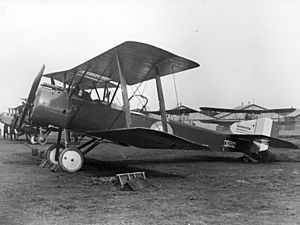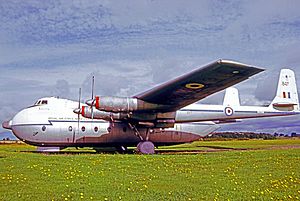No. 70 Squadron RAF facts for kids
Quick facts for kids No. LXX Squadron RAF |
|
|---|---|

Squadron badge
|
|
| Active |
|
| Country | |
| Branch | |
| Type | Flying squadron |
| Role | Strategic and tactical air transport |
| Part of | No. 2 Group RAF |
| Home station | RAF Brize Norton |
| Nickname(s) | Usquam (Latin for 'Anywhere') |
| Aircraft | Airbus A400M Atlas C1 |
| Battle honours |
|
| Commanders | |
| Current commander |
Wing Commander Calvin Bailey M.B.E. |
| Insignia | |
| Squadron badge heraldry | A demi-wing lion erased. Developed from an unofficial winged lion badge probably derived from the squadron's long dependence on the Napier Lion engine during the 1920s. |
No. 70 or LXX Squadron is a special unit of the Royal Air Force (RAF). Its main job is to provide strategic and tactical air transport. This means they move important supplies, equipment, and people by air, often over long distances or into difficult areas. The squadron has a long and interesting history, serving in many conflicts and humanitarian missions around the world.
Contents
History of No. 70 Squadron
Early Years: World War I
No. 70 Squadron was first formed on April 22, 1916, at Farnborough Airfield in the UK. They started with Sopwith 1½ Strutter planes. Soon after, the squadron moved to France to join the fighting in World War I.
In 1917, they upgraded to Sopwith Camel aircraft. These were famous fighter planes. During the war, the squadron was very successful, claiming 287 victories against enemy aircraft. Many skilled pilots, known as "flying aces," were part of No. 70 Squadron.
Between the World Wars
After World War I, the squadron briefly closed down in January 1920. However, it reopened just nine days later in Heliopolis, Egypt. At this time, it became a bomber-transport unit, flying Vickers Vimy bombers.
In December 1921, the squadron moved to Hinaidi, Iraq. They started using Vickers Vernon planes, and later Vickers Victoria aircraft in 1926. These planes were used to carry heavy loads for both air and ground units. They also served as air ambulances and helped keep the important Cairo-Baghdad airmail route open.
A famous event happened in December 1928. There was a conflict in Afghanistan, and No. 70 Squadron played a key role in the Kabul Airlift. Over two months, their Victoria planes helped evacuate 586 British and European people. They flew over mountains as high as 10,000 feet (about 3,000 meters), often in bad weather. This was the first large-scale air evacuation ever!
In November 1934, the squadron replaced their Victorias with Valentia planes. By August 1939, just before World War II, the squadron returned to Egypt.
World War II Missions
When Italy joined World War II, No. 70 Squadron switched to Vickers Wellington bombers. They began flying missions over the Western Desert in North Africa.
In 1940, some of their planes were sent to Greece to help Allied forces. In 1941, the squadron was involved in campaigns in Vichy-controlled Syria and during a rebellion in Iraq.
As the war continued, No. 70 Squadron moved often to support the 8th Army's advance. They moved through Libya and then Tunisia. In November 1943, they moved to Djedeida near Tunis. This location made it easier to reach industrial targets in northern Italy. From December 1943 to October 1945, the squadron was based at Tortorella Airfield, Italy. Here, their Wellingtons were replaced by long-range Liberator bombers.
After World War II: Modern Transport
No. 70 Squadron was disbanded in April 1947, but it reformed quickly in May 1948 at RAF Kabrit, Egypt. They flew Douglas Dakotas until 1950, then switched to Vickers Valettas.
In 1955, the squadron moved to RAF Nicosia, Cyprus. They started using Handley Page Hastings planes, and later Percival Pembroke communication aircraft. In 1966, they moved to RAF Akrotiri. After a short time flying Armstrong Whitworth Argosy C.1s, the squadron began using the Lockheed C-130 Hercules in 1970.
After 55 years serving overseas, the squadron moved back to the UK, to RAF Lyneham, in 1975. They operated Hercules C1/C3 aircraft for 35 years. The squadron was disbanded again in September 2010.
However, No. 70 Squadron reformed on October 1, 2014. On July 24, 2015, Princess Anne officially presented them with a new standard. This made them the RAF's first frontline squadron to fly the Airbus A400M Atlas.
In 2017, the squadron helped with Operation RUMAN, providing humanitarian aid after Hurricane Irma. In August 2021, they were sent to Al Minhad Air Base in Dubai, United Arab Emirates. From there, two of their aircraft helped with Operation Pitting. This was the largest Royal Air Force airlift since the Berlin Airlift. They helped evacuate British citizens and vulnerable Afghan people from Kabul International Airport.
Aircraft They Flew
No. 70 Squadron has flown many different types of aircraft throughout its history. Here are some of the main ones:
| Dates | Aircraft | Type | Notes |
|---|---|---|---|
| 1916–1917 | Sopwith 1½ Strutter | Fighter | A single-engine biplane |
| 1917–1919 | Sopwith Camel | Fighter | A famous single-engine biplane |
| 1919 | Sopwith Snipe | Fighter | A single-engine biplane |
| 1920 | Handley Page 0/400 | Bomber | A large twin-engine biplane |
| 1920–1922 | Vickers Vimy | Bomber | A twin-engine biplane |
| 1922–1926 | Vickers Vernon | Transport | A twin-engine biplane |
| 1924–1935 | Vickers Victoria | Transport | Different versions of this twin-engine biplane |
| 1935–1940 | Vickers Valentia | Transport | A twin-engine biplane |
| 1940–1945 | Vickers Wellington | Medium Bomber | Different versions of this twin-engine bomber |
| 1945–1946 | Consolidated Liberator | Bomber | A four-engine bomber |
| 1946–1947 | Avro Lancaster | Bomber | A famous four-engine bomber |
| 1948–1950 | Douglas Dakota | Transport | A twin-engine transport plane |
| 1950–1956 | Vickers Valetta | Transport | A twin-engine transport plane |
| 1956–1968 | Handley Page Hastings | Transport | A four-engine transport plane |
| 1967–1975 | Armstrong Whitworth Argosy | Transport | A four-engine transport plane |
| 1970–2010 | Lockheed Hercules | Transport | Different versions of this four-engine transport plane |
| 2014–present | Airbus A400M Atlas | Transport | A modern four-engine transport plane |
See also
- List of RAF squadrons



